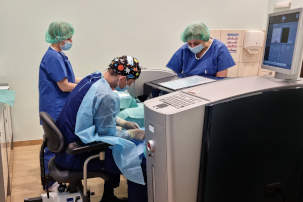
Laser vision correction — TransPRK (StreamLight) method |
| 26.04.2022 |
 Our last article presented the most substantial information regarding the SBK LASIK method. Now it is time to bring you closer to another correction method, a so-called superficial method, namely TransPRK.
Our last article presented the most substantial information regarding the SBK LASIK method. Now it is time to bring you closer to another correction method, a so-called superficial method, namely TransPRK.
TransPRK (Transepithelial Photorefractive Keratectomy) is a modification of an earlier PRK (Photorefractive keratectomy) method. In the first stage of the surgery, an excimer laser removes the corneal epithelium and then corrects the refractive error by properly reshaping the cornea. Apart from a speculum that is used to hold the eyelids from the very beginning of the surgery, no additional surgical instruments are used during the procedure.
The epithelial layer grows back after approximately 3-4 days following the surgery. Until then patients may experience pain sensations and discomfort in the form of stinging and hypersensitivity to light – both solar and artificial one.
This method is particularly suitable for patients susceptible to eye injuries, such as sportspeople and employees of the uniformed services (firefighters, soldiers). TransPRK offers a chance for laser vision correction to patients with an extremely thin cornea or corneal scars who cannot undergo an SBK LASIK procedure for medical reasons.
Immediately after the procedure, after the effect of the anaesthetic drops wears off, the patient experiences pain and severe lacrimation. The next morning, the eyelids may be slightly swollen. The patient is likely to feel a sensation of sand under the eyelids and stinging. These ailments usually last 4-7 days. During this time, patients take painkillers according to their own preferences.
Depending on the corrected vision defect and individual features of each patient, the recovery time following the surgery will look different. After a TransPRK procedure, it lasts longer than in the case of methods in which a corneal flap is created, e.g. an SBK LASIK procedure, and it usually takes about 5-14 days.
Regardless of the method, however, we assume that the corneal healing takes about a month, which is why it is necessary during this time to avoid staying in dusty or smoky rooms, bathing in water reservoirs (swimming pool, sea), and using a sauna.
Physical effort after having a TransPRK surgery is allowed slightly earlier than after an SBK LASIK procedure – but not earlier than after a two-week break from training. The treating physician bases the final decision regarding the return to the gym on the monitoring of the corneal healing process.
Light effects around the sources of light, especially in the evenings, are a very common phenomenon, as well as a much longer adaptation to close-range vision. For the first month after the procedure, patients who work in front of a computer screen experience eye fatigue sooner than normal.
In the case of a TransPRK surgery, a follow-up appointment is scheduled one week after the procedure.
The improvement of vision after the procedure is already so noticeable that the patient does not need to wear corrective glasses, but it is gradual. In the first days, it may fluctuate and be different each day (sometimes better, sometimes worse). It is connected with swelling of the cornea after the surgery and regeneration of its epithelium. The stabilization of vision until the intended effect is reached can take from several weeks to half a year, depending on the value of the corrected vision defect and adherence to the post-operative recommendations.